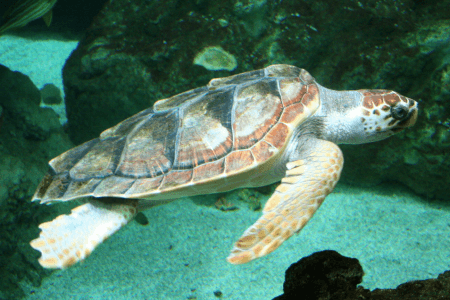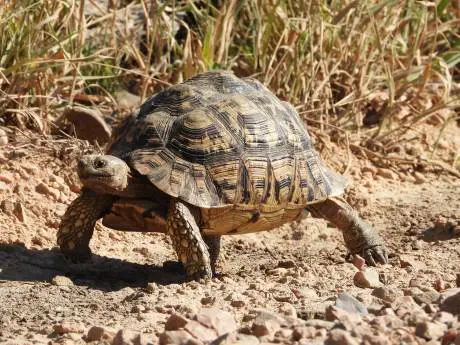Turtles and tortoises belong to one of most ancient reptile families, and have existed for 157 million years. They are older than snakes and crocodiles, but some turtle species are now highly endangered due to human consumption. Turtles belong to the order Testudines (from Latin word testudo or “tortoise”) which includes freshwater and sea-dwelling types. Let us find out if there are major differences between these two reptiles.
Summary Table
| Turtle | Tortoise |
| Mostly aquatic reptiles. | Mostly land-based turtles. |
| Most have flippers or webbed feet, lighter and flatter shells. | Most have short, sturdy legs and heavier shells. |
| Usually omnivorous. | Usually herbivorous. |
Descriptions

The definition of the word “turtle” varies depending on where you are in the world. In North America, it is a blanket term that includes tortoises and terrapins. The British use the word turtle to refer to the sea-dwelling species. Other species of turtles include tortoises and terrapins. Tortoises generally live on land, while terrapins normally inhabit brackish waters such as in estuaries where freshwater mixes with seawater. In Spain, tortuga is used to refer to turtles, terrapins, and dolphins.
The largest living turtle is the leatherback sea turtle. Its shell can grow up to 6.6 feet or 200 centimeters and can be as heavy as 900 kilograms or 2,000 lbs. The smallest turtle, just 3.1 inches or 8 centimeters in length, is the speckled padloper tortoise found in South Africa.
Turtles have lighter shells than land-dwelling tortoises. Flatter, lighter shells allow aquatic turtles to swim better and faster. Large spaces in the shell called fontanelles make the shells lighter. Most turtles are omnivores feeding on aquatic plants, snails, worms, and insects. Certain species are known to feed on dead marine animals, small fish, and other marine animals. Sea turtles eat jellyfish and other smaller marine creatures.
Turtles have webbed feet for swimming and long, strong claws for climbing up riverbanks or logs. Some turtle species have developed flippers with shorter claws rather than webbed feet. Some aquatic turtles have their eyes near the top of their head, allowing them a better view above the water.

The tortoise is a land-dwelling reptile that belongs to the Testudinidae family. It is under the order Testudines, along with sea-dwelling and aquatic turtles. Tortoises usually have heavier shells than their close relatives and are generally known to be more solitary.
As mentioned earlier, the words tortoise, turtle, and terrapin are used interchangeably depending on the region you’re in. However, according to the American Society of Ichthyologists and Herpetologists, the term “turtle” covers all land and sea turtles under the order Testudines. They use the term tortoise to point specifically to the slow-moving land species.
Found usually in Africa and Asia, tortoises are generally plant-eaters feeding on weeds, grasses, green leaves, and even flowers. Some tortoise species are omnivores that feed on insects and worms.
One of the more distinct characteristics of tortoises as land-dwellers are their short and sturdy feet. They are extremely slow, walking at 0.27 kilometers per hour or 0.17 miles per hour.
Turtle vs Tortoise
What’s the difference between a turtle and a tortoise then? Using the American Society of Ichthyologists and Herpetologists definition, a turtle is a reptile with a hard, bony shell belonging to the order of Testudines which includes all sea, land, and other aquatic turtles. The term tortoise is used to describe most land-dwelling turtles. With this definition, we can highlight their general differences.
A turtle is a reptile with a hard, bony shell belonging to the order of Testudines. The tortoise belongs to the same order but is under a different classification. Most turtles live as sea-dwellers, while some are amphibious, meaning they can live on both land and sea. There are freshwater turtles and other species that live in estuaries where freshwater meets seawater. A tortoise is another species that mostly live on land.
Most aquatic or semi-aquatic turtles have developed flippers, along with lighter and flatter shells that allow them to swim more efficiently in the water. Other turtles have webbed feet with claws to climbing up logs and muddy riverbanks. Tortoises have short but strong limbs that give them mobility on land.
Turtles have been known to swim in the sea in groups (called a bale), while tortoises are recognized as solitary animals. Most turtles are omnivores feeding on aquatic plants, snails, worms, and even dead marine animals while tortoises are usually herbivores that like eating grasses, weeds, and flowers.
Video
Here’s a quick video that highlights a few important differences between these two reptiles:
Box turtles are the only tortoises that live in wooded areas. A few species of turtles and tortoises are threatened by habitat loss, over-hunting, poaching, and global warming.
In general, tortoises have short legs and are built like a ball with large rounded feet to walk on land. They also have thick shells that help them hide in their natural environment. Turtles have long legs with flattened feet and small roundish heads that make them agile in the water but slower on land.
Turtles spend most of their time on water or on land so they need a lot of energy to move about. They often hunt for food during the night when it is dark out. Tortoises prefer the sun to move around during the day, so they are active throughout the day and night to hunt for food and to find shelter from predators.
The lifespan of turtles is much longer than tortoises. For example, the Aldabra giant tortoise has been recorded to live for over 100 years. Tortoises have an average lifespan of between 60 and 100 years, with some individuals living up to 150 years.
Tortoises lay eggs, which are covered in a shell. Turtles lay eggs without a shell. Most turtles have a cloaca, which is a part of the digestive system that also serves as an anus and is common to most animals. Tortoises have a separate opening called the cloaca that helps them defecate and urinate.
Differences Between Tortoise Shells and Turtle Shells
There are a lot of differences between tortoise and turtle shells. Tortoises have a flat, rectangular shell while turtles have a domed shell. Turtle shells are generally more robust and their heads are generally smaller than tortoises. The turtle shell is made of bone, while the tortoise shell is made of keratin.
Some chelonian species have armor on their shells that has evolved to be larger and stronger than the shells of other species. These include some iguanas, anoles, and boas. Turtles and tortoises are closely related and there are many similarities between the two groups. Chelonia and testudines have the same family, Cheloniidae.
The rib cages of turtles and tortoises are separated by a diaphragm, and their lungs are contained within their rib cage. Tortoises also have a keel on the bottom of their shell, which helps them to move more easily. Tortoises have a shorter tail than turtles, and their tails are shorter in proportion to their bodies.
The hind legs of turtles and tortoises are adapted for digging, and the front legs are used for walking. Turtles and tortoises also have a joint in their shoulders which allows them to turn their heads to the side. The fore limbs of turtles and tortoises are not as adapted for digging as the hind limbs. Turtles and tortoises have a unique ability to turn their heads 180 degrees in either direction, unlike other reptiles.
Effects of Climate on Turtle and Tortoise Shells
The temperature of the environment has a big effect on the shell. Tortoises and turtles will move their bodies to adjust to changes in the climate. In warmer temperatures, turtles and tortoises will have thicker shells. Turtles in colder climates will have thinner shells to keep them warm. When the temperature rises, turtles and tortoises need to shed their shells or become too hot for their bodies to handle.
Types of Turtle and Tortoise
There are several types of turtles and tortoises, including the leatherback sea turtle, snapping turtle, diamondback terrapin, green turtle, box turtle, red-eared slider, softshell turtles, galapagos tortoise, and so on. There are also tortoises that live in the desert, such as the gopher tortoise and the desert tortoise.
Some species of turtles and tortoises have developed certain unique features. For example, some of them can move their eyes to look sideways in order to be able to see their surroundings. They also have special hearing capabilities to be able to detect their prey. The eyes of turtles and tortoises are always in front of the head and they are positioned similarly. Tortoises are also able to rotate their necks when eating grasses.
The long claws of turtles and tortoises are used to dig holes in the ground, to help them escape from predators. The box turtle has a hard shell and the front of the shell is flattened while the back is concave. It also has long legs that help it move around. The snapping turtle has long, sharp claws that are used to grab its prey and make quick movements.
Pet Turtle and Tortoise
Tortoises and turtles are not as popular as other reptiles. They are also less likely to be kept as pets. They can be kept in a cage with a basking light, but most of the time they will be kept in their natural environment. A pet turtle or tortoise should be kept in a quiet, warm area with plenty of humidity. They should also be provided with a large, covered area for basking.
If you want to keep a pet turtle or tortoise, it is important that you provide the right environment for them to live in. A small tank is best for a turtle or tortoise, but it should be large enough for the animal to move around in and safe from predators such as cats and dogs. The tank should have plenty of hiding places so that your pet can feel safe when it is not being watched by its owner.





